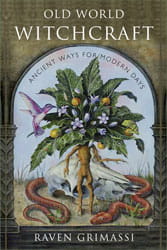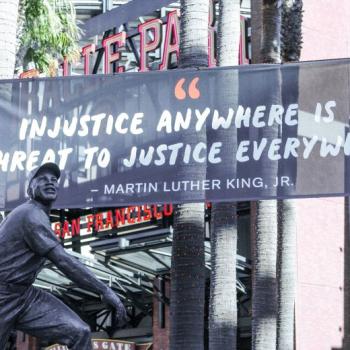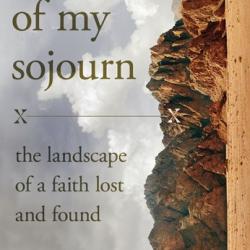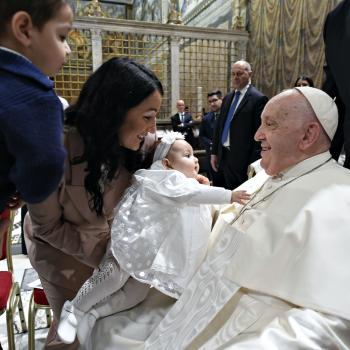 Now Featured at the Patheos Book Club
Now Featured at the Patheos Book Club
Old World Witchcraft: Ancient Ways for Modern Days
by Raven Grimassi
Book Excerpt
The Enchanted World of the Witch
To better understand the witch figure, we need to look to more than just the daily affairs of the witch. Our attention should also go to her or his enchanted world view, which we will explore in this chapter. For simplicity in this section I will use "she" and "her" when referring to a witch, and ask that it be understood not to exclude men. It is in revealing the mystical world of the witch that we begin to learn about her perceived relationship to it all. The witch's interaction with such realms guides her actions. Knowing why the witch performs a specific act is more enlightening than simply looking at the results. The witch is not without ethics as many would claim. But in reality it is simply difficult for someone who is harmed to take responsibility for provoking the witch to begin with.
Even more realistic ideas of witches and their practices are found in the period following the decline in the belief of the witches' Sabbat and diabolical revelry. As reason began to direct the minds of both the learned and the uneducated, people were better able to see the very human witch who lived in or near their villages and towns. We see signs of this in the eighteenth century, and by the late nineteenth century the witch appears as a fairly believable character. Remnants of old superstitions did still pop up, but they no longer resulted in hysteria and the killing of the witch. However, fear, misunderstanding, and ignorance remained firmly in place.
The type of witch who is the subject of this book is fully human and yet is often associated with the so-called supernatural world. This is where tales of the witch and the faery merge together, and such tales are often inextricably interwoven. The concept appears throughout Europe with little significant difference. Sicilian folklorist Giuseppe Pitrè once noted that it is difficult to clearly distinguish between a faery and a witch in the old tales. Old woodcuts depict faery mounds that are also featured in tales about witches and faery contact. These mounds are often located on or near prehistoric sites that are still associated with folk legends.
It is noteworthy that some of the witchcraft trials mention specific places where prehistoric gathering sites are located. At these sites we find barrows, dolmens, and megalithic monuments. Some people accused of witchcraft spoke of visits to these places where they met with faeries. One particularly interesting account comes from a man named John Walsh who was tried for witchcraft in 1566. Walsh informed his examiners that he learned witchcraft from the faeries whom he met at a barrow. His story included details about three types of faeries: white, green, and black. The latter he regarded as very troublesome.
In 1623 a woman named Isabel Haldane, who was accused of being a witch, reported that she discovered the "faery land" in a hollow hill. Another accused individual, Jacob Behmen, was tried in 1654 and also spoke of gaining access to the realm of the faeries by knocking three times on a fairy hill. One other example is that of Isobel Gowdie, accused of witchcraft in 1664. She admitted to visiting a faery place known as Downie Hill where she claimed to feast with the king and queen of the faeries.
French folklorist Émile Nourry (pseudonym Pierre Saintyves) investigated areas in the vicinity of megalithic monuments to see if stories existed linking them to accounts of witchcraft. He was intrigued that many bore names suggesting these places were once gathering sites for the practice of witchcraft. One particular site at Vaumont is named La Pierre du Sabbat, which suggests an association with witches' gatherings. Another is named La Cusine des Sorciers (The Sorcerer's Kitchen) and is attached to legends that witches used this site to make their potions.
Modern witches are drawn to using ancient sites associated with ritual and magical practices. One reason is that something mystical seems to call from there to the inner spirit. It is intuitively felt as a place of power or a connection to a meeting place between this world and the next. If witches met in days of old at these ancient sites, the reasons may have been similar. Perhaps it was simply a way of trying to return home to the world as it was before the One God came to displace the Many.
Some of the old sites have been connected to reported UFO activity. An associate of my mine who is an anthropologist once pointed out the similarities between UFO lore and faery lore. Both involve lights that move in the sky, strange looking creatures, nighttime encounters, kidnapping, and time displacement. Whatever this phenomenon is, it seems to have been around for a very long time. The explanation for it is always in accord with the technology of the period. In the Middle Ages the explanation was faery activity, and in our contemporary era the explanation is extraterrestrial visitations. Centuries from now it will likely be something else.




